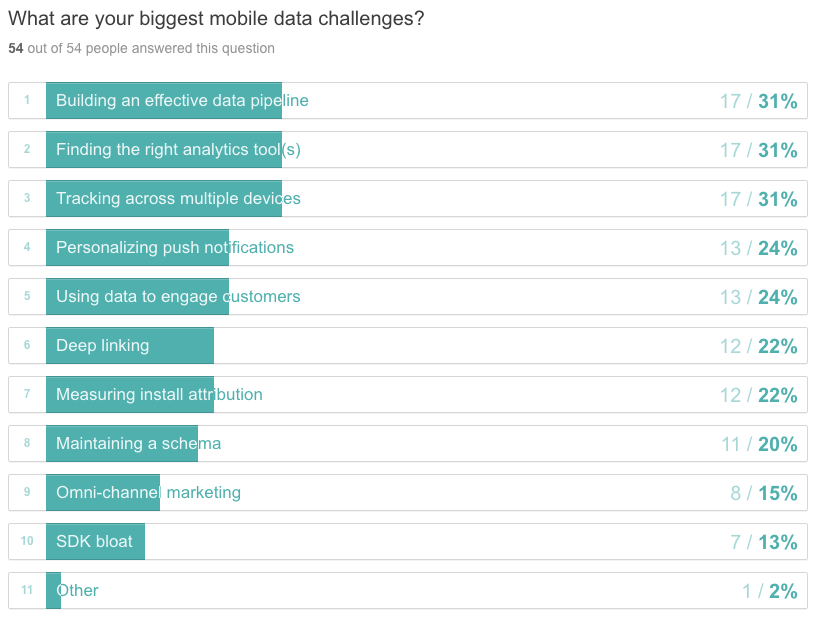Expert Advice on Common Mobile Data Challenges
Capturing high quality customer data on mobile devices is essential to making products that customers love. But the process to capture that data can be tedious. We polled attendees at our recent WWDC meetup—a mix of engineers, data analysts, and growth marketers—on their biggest mobile data challenges.
Our poll results showed foundational steps still pose the biggest obstacles to many teams:
Building an effective data pipeline.
Finding the right analytics tool(s).
Tracking across multiple devices.

Last week, Hakka Labs and Segment teamed up to host an event about the right way to track mobile data. We recruited panelists from Instacart, Pandora, Branch Metrics, Invoice2go, and Gametime to discuss mobile customer data collection and share their experience in overcoming data obstacles.
A video of the entire panel will be available soon. In the meantime, we wanted to share some of the insights we learned about the biggest mobile data challenges affecting teams today.
Building an effective data pipeline:
There are several steps to building an effective data pipeline. But here are the two you should start with:
Develop a naming schema that’s followed across your company — and teach your company to follow it.
Implement a central repository for all of your data.
“Maintaining a schema is a challenge,” said Gautam Joshi, Engineering Program Manager of Analytics at Pandora. This was a sentiment that was echoed by others on the panel and our poll participants. He added, “There is always a tradeoff between governance and putting people close to the data in charge of tracking. For example, we’ve decided to implement analytics at the PM level for each product. That makes it harder to enforce naming conventions, but does help that PM make sure he has the data he needs to analyze a feature’s performance.”
Instacart embeds analysts on product and marketing teams to set the tracking schema and KPIs from the beginning of projects. It’s on the analysts to standardize the data and make it easy to use. Instacart has found that leaving this to the analysts ensures that the data provides what the team is looking for in the end.
But the schema is only part of it. To give you a more complete perspective on how business is performing, you should bring your customer data from various systems into a central repository. “You can’t optimize for just one metric, or it will all fall apart,” said Che Horder, Director of Analytics at Instacart.
“If you optimized for one metric, you’re inevitably going to miss other important things,” added Beth Jubera, Senior Software Engineer at Invoice2go. “For example, when we were optimizing for app reviews, people started complaining in reviews that we should stop asking for reviews! Since then, we’ve made sure to balance at least two metrics so we don’t over-optimize one at the sacrifice of user experience in other places.”
Finding the right analytics tool:
Once you’re collecting data, figuring out how to make it actionable is a wholly separate challenge. A number of the panelists recommended Amplitude and Periscope for analysis, but your own data needs might differ. Horder and Jubera both talked about how Segment makes it easier to try new tools. It even allows you to keep your historical data, so that you can use a new tool as if you’ve had it on since day one.
Tracking data across multiple devices:
26% of ecommerce purchases start on a mobile device (but finish elsewhere), which makes cross-device tracking crucial. Mada Seghete, co-founder of Branch Metrics, built her entire business on the idea that without an effective method of tracking user activity across devices, you’re missing a big part of story.
“We track across mobile and web by tying user-level tracking with device IDs,” said Jubera. Horder said they make sure they use the same naming taxonomy across devices to analyze the same features and understand how user behavior differs between devices.
For example, by tracking performance across different platforms, Instacart discovered that their shopper app performed slowly on a few types of Android devices, and now they’re working on enhancements to make every version faster. As a Segment Warehouses customer, they’re able to combine online and offline data from their mobile app, website, and other back office systems to connect the dots across the entire customer experience.
Other tips:
We’ve found that most data engineers want the same things: to collect customer data and use it to create a product that their customers love. And they seem to have similar pain points in getting there. Here are some additional recommendations:
Front load the planning. Start with a tracking plan.
Have a clear thesis. Nothing ships without hypothesis, goal and metrics.
As you progress, hold teams accountable to the data.
Always talk to your customers, even after product market fit.
While your solution will no doubt be specific to your use case, you can certainly learn a lot from those who’ve already overcome common similar challenges. Creating a data-driven culture is hard, but totally worth it. As John Hession, VP of Growth at Gametime, said, “Data is all we care about.”

Our annual look at how attitudes, preferences, and experiences with personalization have evolved over the past year.